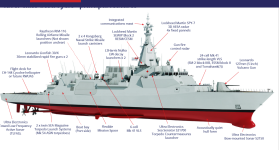I think Hunter is a bit ahead of CSC, but there are pretty significant internal differences on the 3 classes, and the masts on all 3 will be very different. I imagine they got rid of something inside to fit extra VLS cells without adding length.
Seems like Hunter has a few different phased array radars in different bands but it's not like the SPY 7 is some kind of lightweight radar either; it just may be less massive than more massive setup.
If you stick a 5 lb weight on the end of the broom handle and hold it out at full extension, gives a good idea of how much weight high impacts stability with a really big lever in the form of a mast, and why it has an outsized impact on ship stability. Ballast is 'wasted' weight margin (compared to equipment that provides operational capability), so is why both CSC and Hunter are heavier than T26 in a lot of respects. Note the Hunter Wiki includes both light ship and full operational weights, while the CSC doesn't, so the heavier weight is probably also more honest reporting of true weight when fully booted and spurred. The full operational weight can easily add another 10% displacement in ammunition, liquid ballast, extra people, stores etc.
Hunter-class frigate - Wikipedia
River-class destroyer (2030s) - Wikipedia





